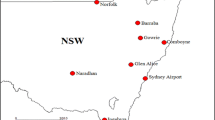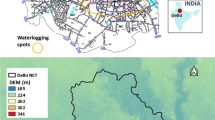Abstract
In a sustainable urbanisation process, the infrastructure has to be designed taking into consideration the hydrological behaviour of the respective catchment. It is mandatory to predict the climatic events accurately to understand the hydrological impacts of urban developments. It is very challenging for hydrologists to model extreme events when there are limited data available. The current study proposed a methodology to calculate the design rainfalls in the coastal region of Sao Paulo, Brazil. The gamma-function distribution used the annual maximum daily rainfalls in a probabilistic approach. The achieved 24-h-design rainfalls were compared to the results from other intensity–duration–frequency equations in different time-series. The rainfall disaggregation used regional and national conversion ratios. The fluctuation of the annual maxima revealed that the study area was affected by the Noah and Joseph erratic processes. Subsequently, the detected extreme event time-series were also used for the derivation of the 24-h-design rainfalls. The outcomes of the study showed that the gamma-function distribution provides reliable results, enhanced by the use of representative disaggregation ratios and proper time-series.
Similar content being viewed by others
References
Alfieri L et al (2012) Operational early warning systems for water-related hazards in Europe. Environ Sci Policy 21:35–49
Almeida EG (2013) Tromba d’água–Catástrofe de 1967 em Caraguatatuba. Photo Archive. At: Museu de Arte e Cultura de Caraguatatuba (MACC)/Fundação de Arte e Cultura de Caraguatatuba (FUNDACC)
Arnbjerg-Nielsen K et al (2013) Impacts of climate change on rainfall extremes and urban drainage systems: a review. Water Sci Technol 68(1):16–28
Barbassa AP et al (2009) Sistema computacional para vetorização de pluviogramas. In: XVIII Simpósio Brasileiro de Recursos Hídricos, 22–26 November 2009, Campo Grade, MS. Campo Grande: ABRH
Campos JNB (2009) Lições em modelos e simulação hidrológica. ASTEF/Expressão Gráfica, Fortaleza
Caraguatatuba (2011) City master plan of Caraguatatuba Municipality, Law n. 42, 24 November 2011
Chernoff H, Lehmann E (1954) The use of maximum likelihood estimates in Chi squared tests for goodness of fit. Ann Math Stat 25(3):579–586
Chow VT (1953) Frequency analysis of hydrologic data with special application to rainfall intensities. University of Illinois at Urbana Champaign, College of Engineering. Engineering Experiment Station
Chow VT (1958) Frequency analysis in small watershed hydrology. Agric Eng 39(4):222–231
Company of technology in environmental sanitation of the State of Sao Paulo (CETESB) (1986) Drenagem urbana: manual de projeto. DAEE/CETESB, São Paulo
Department of Water and Electric Energy of the State of Sao Paulo (DAEE) (2016) Precipitações Intensas do Estado de São Paulo. DAEE-CTH, São Paulo
Fisher RA, Tippett LHC (1928) Limiting forms of the frequency distribution of the largest or smallest member of a sample. Proc Camb Philos Soc 24:180–190
Frechet M (1927) Sur la loi de probabilite de l’ecart maximum. Annales de la Société Polonaise de Mathématique 6:93–116
Gaume E et al (2009) A compilation of data on European flash floods. J Hydrol 367(1–2):70–78
Gericke OJ, du Plessis JA (2011) Evaluation of critical storm duration rainfall estimates used in flood hydrology in South Africa. Water SA 37(4):453–469
Gumbel EJ (1941) The return period of flood flows. Ann Math Stat 12:163–190
Gyasi-Agyei Y (2005) Stochastic disaggregation of daily rainfall into one-hour time scale. J Hydrol 309(1–4):178–190
Husak GJ, Michaelsen J, Funk C (2007) Use of the gamma distribution to represent monthly rainfall in Africa for drought monitoring applications. Int J Climatol 27(7):935–944
Jenkinson AF (1955) The frequency distribution of the annual maximum (or minimum) values of meteorological elements. Q J R Meteorol Soc 81(348):158–171
Knoesen D, Smithers J (2009) The development and assessment of a daily rainfall disaggregation model for South Africa. Hydrol Sci J 54(2):217–233
Koutsoyiannis D (2004) Statistics of extremes and estimation of extreme rainfall: I. Theoretical investigation. Hydrol Sci J 49(4):575–590
Koutsoyiannis D, Onof C (2001) Rainfall disaggregation using adjusting procedures on a Poisson cluster model. J Hydrol 246(1–4):109–122
Koutsoyiannis D, Kozonis D, Manetas A (1998) A mathematical framework for studying rainfall intensity-duration-frequency relationships. J Hydrol 206(1–2):118–135
Lian JJ et al (2013) Joint impact of rainfall and tidal level on flood risk in a coastal city with a complex river network: a case study of Fuzhou City, China. Hydrol Earth Syst Sci 17(2):679–689
Machado RL et al (2010) Spatial variability of maximum annual daily rain under different return periods at the Rio de Janeiro state, Brazil. Bragantia 69:77–84
Mandelbrot BB, Wallis JR (1968) Noah, Joseph and operational hydrology. Water Resour Res 4(5):909–918
Martins D et al (2013) Determinação da Equação de Chuvas Intensas para a Cidade de Caraguatatuba-SP. In: XX Simpósio Brasileiro de Recursos Hídricos, 17–22 November 2013, Bento Gonçalves, RS. Bento Gonçalves: ABRH
Millington N, Das S and Simonovic SP (2011) The Comparison of GEV, Log‐Pearson Type 3 and Gumbel Distributions in the Upper Thames River Watershed under Global Climate Models. Department of Civil and Environmental Engineering, The University of Western Ontario—Canada, Report n 77, set 2011
Naghettini M, Pinto EJDA (2007) Hidrologia estatística. CPRM–Serviço Geológico do Brasil, Belo Horizonte
Paiva RCD et al (2011) Reduced precipitation over large water bodies in the Brazilian Amazon shown from TRMM data. Geophys Res Lett 38:L04406. https://doi.org/10.1029/2010GL045277
Pfafstetter O (1982) Chuvas intensas no Brasil; relaçao entre precipitaçao, duraçao e freqüência de chuvas em 98 postos com pluviografos. Departamento Nacional de Obras e Saneamento, Rio de Janeiro
Plackett RL (1983) Pearson, Karl and the Chi squared test. Int Stati Rev 51(1):59–72
Pombo CC (2017) Há 50 anos: após três dias ininterruptos de chuvas, Caraguatatuba sofreu pior tragédia de sua história. Folha de São Paulo, 18 March 2017. http://acervofolha.blogfolha.uol.com.br/2017/03/18/ha-50-anos-apos-tres-dias-ininterruptos-de-chuvas-caraguatatuba-sofreu-pior-tragedia-de-sua-historia/. Accessed 19 March 2017
Righetto AM (1998) Hidrologia e recursos hídricos. EESC/USP, São Paulo
Ryu J et al (2014) Statistical evaluation on storm sewer design criteria under climate change in Seoul, South Korea. Urban Water J 11(5):370–378
Shrestha A et al (2017) Developing Intensity–Duration–Frequency (IDF) curves under climate change uncertainty: the case of Bangkok, Thailand. Water 9(2):145
SIGRH (2016) Information system for the water resources management of the state of Sao Paulo. http://www.sigrh.sp.gov.br/. Accessed 27 July 2016
Skaugen T (2007) Modelling the spatial variability of snow water equivalent at the catchment scale. Hydrol Earth Syst Sci 11(5):1543–1550
Slade JJ (1936) The reliability of statistical methods in the determination of flood frequencies. Geological Survey Water-Supply, Paper 771, Washington
Smithers JC, Schulze RE (2004) The estimation of design rainfalls for South Africa using a regional scale invariant approach. Water SA 30(4):435–444
Weiss LL (1964) Ratio of true to fixed-interval maximum rainfall. J Hydr Div 90(1):77–82
Wilk J, Hughes DA (2002) Calibrating a rainfall-runoff model for a catchment with limited data. Hydrol Sci J 47(1):3–17
Young CC, Liu WC (2015) Prediction and modelling of rainfall-runoff during typhoon events using a physically-based and artificial neural network hybrid model. Hydrol Sci J 60(12):2102–2116
Youssef AM, Maerz NH (2013) Overview of some geological hazards in the Saudi Arabia. Environ Earth Sci 70(7):3115–3130
Zuffo AC (2004) Equações de chuvas são eternas. In: XXI Congresso Latinoamericano de Hidráulica, 18–22 October 2004, São Pedro, SP. São Pedro: IAHR
Zuffo AC (2015) O Sol, o motor das variabilidades climáticas. Rev DAE 63:6–24
Zuffo AC, Zuffo MSR (2016) Gerenciamento de Recursos Hídricos: Conceituação e Contextualização, 1st edn. Elsevier, Rio de Janeiro
Acknowledgements
We gratefully acknowledge UNICAMP and the Brazilian National Council for the Improvement of Higher Education (CAPES) for the study support, and the Australian Government for the Research Training Program (RTP) Fees Offset Scholarship at Swinburne University of Technology.
Author information
Authors and Affiliations
Corresponding author
Appendices
Appendix A
The calculation of the gamma-function parameters and the test statistic for the rain gauges (see Tables 6, 7, 8 and 9).
Appendix B
The calculation of the gamma-function parameters and the test statistic for the rain gauges during the extreme event time-series (see Tables 10, 11).
Appendix C
Exemplification of the rainfall disaggregation with different ratios
-
(a)
Downscaling the 24 h to 12 h rainfalls for the gamma distribution design rainfall of the E2-046 station (65 years), by the use of the CETESB ratio:
-
From Table 2
CETESB RATIO
Original duration
Final duration
Conversion ratios
1 day
24 h
1.14
24 h
12 h
0.85
-
The gamma distribution values are multiplied by 1.14 (converting the 1 day to a 24 h rainfall) and then by 0.85 (converting the 24 h to a 12 h rainfall)
Gamma-CETESB
Return period (years)
Design rainfall (1 day)
Design rainfall (24 h)
Design rainfall (12 h)
2
100.60
114.69
97.48
5
138.68
158.09
133.03
10
161.87
184.53
155.20
15
174.31
198.72
167.11
20
182.79
208.38
175.21
25
189.19
215.68
181.33
50
208.31
237.47
199.60
100
226.51
258.22
217.00
-
(b)
Downscaling the 24 h to 12 h rainfalls for the gamma distribution design rainfall of the E2-046 station (65 years), by the use of the DAEE-Caraguatatuba (CAR) ratio:
-
From Table 3:
DAEE-CAR RATIO
Original duration
Final duration
Conversion ratios
1 day
24 h
1.14
24 h
12 h
0.88
-
The gamma distribution values are multiplied by 1.14 (converting the 1 day to a 24 h rainfall) and then by 0.88 (converting the 24 h to a 12 h rainfall):
Gamma-CAR
Return period (years)
Design rainfall (1 day)
Design rainfall (24 h)
Design rainfall (12 h)
2
100.60
114.69
100.93
5
138.68
158.09
139.12
10
161.87
184.53
162.38
15
174.31
198.72
174.87
20
182.79
208.38
183.37
25
189.19
215.68
189.80
50
208.31
237.47
208.98
100
226.51
258.22
227.23
Rights and permissions
About this article
Cite this article
Boulomytis, V.T.G., Zuffo, A.C. & Imteaz, M.A. Derivation of Design Rainfall and Disaggregation Process of Areas with Limited Data and Extreme Climatic Variability. Int J Environ Res 12, 147–166 (2018). https://doi.org/10.1007/s41742-018-0079-x
Received:
Revised:
Accepted:
Published:
Issue Date:
DOI: https://doi.org/10.1007/s41742-018-0079-x












